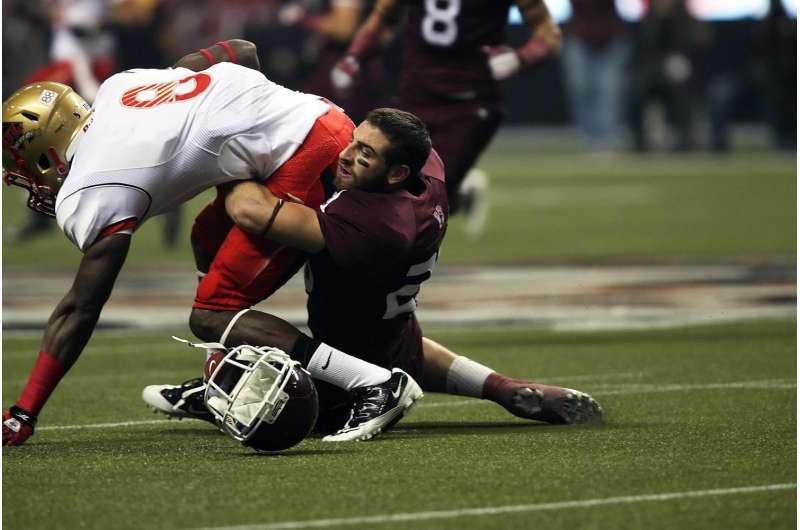Credit: CC0 Public Domain
The largest study of concussion ever conducted in college athletes is redefining the timeline for recovery as a process taking up to 28 days, up from the suggested normal recovery time of up to 14 days.
The findings are detailed in the journal Sports Medicine, in one of the marquee papers to emerge from the NCAA-DoD Concussion Assessment, Research and Education Consortium. The study's lead researcher, Steve Broglio, director of the University of Michigan Concussion Center, is on the CARE Consortium leadership team and leads the CARE clinical study core.
"Normal return-to-play time was previously set at 14 days––meaning 50% of people recovered in that time. Our paper suggests that 28 days more fully encapsulates the recovery process. At that point, 85% of people have returned to play," Broglio said.
The study found that though median recovery times were consistent with the previously suggested 14 days, it was not until one month post-injury that most athletes were cleared for unrestricted sport participation.
This doesn't mean that universities must revise their return to play protocols.
"The RTP protocols are driven by clinical presentation (symptoms), not time, so they don't need to be revised," Broglio said.
Rather, coaches, parents and athletes should reframe their expectations for return to play, in part to avoid stigmatizing concussed athletes who take longer than 14 days to recover, he said. Reframing the normal recovery time to 28 days helps eliminate unintentional social pressure from teammates, coaches or parents who hope to see their player back on the field. If a concussed athlete takes longer than 14 days or up to a month, that's completely normal, he said.
There wasn't much variation in recovery times among study subgroups, with various factors altering recovery by only up to two days. The total return-to-play duration was shorter with ADHD medication usage, males and greater assessment frequency. Those with greater initial post-injury symptom severity, practice/training-related injuries and three or more prior concussions had longer recoveries.
Concussion management recommendations are outlined every four years by the Concussion in Sport Group, an international body that reviews the medical literature and develops guidelines on clinical care. This paper and others resulting from the CARE Consortium will likely be taken into consideration when the group meets next year, said Broglio, who is also a member of CISG.
Despite increased research in concussion over the previous decade, the trajectory of concussion recovery times across diverse populations of athletes has remained poorly defined, because most sport concussion research centered on male athletes in collision sports, or on female soccer players, Broglio said.
The current study included 34,709 male and female athletes from 30 colleges and universities—more than 1,700 of whom were concussed while participating in 22 sports.
Concussed male athletes most commonly played football (54.7%), soccer (10.7%), basketball (6.8%) and wrestling (6.4%), while concussed female athletes most commonly played soccer (23.4%), volleyball (14%), basketball (12.9%) and lacrosse (8.4%). Broglio said male and female athletes took about the same amount of time to recover from concussion, give or take a day.
Concussion education and treatment has improved dramatically in the last two decades, he said.
"Back when I started in concussion research 20 years ago, we'd manage these injuries with a light switch. We'd ask, 'Do you have symptoms?' and if the answer was no, the athlete was put back on the field. Gone are the days when concussed athletes are put back in the same day," Broglio said. "Now, we can think of it as a dial, where we slowly progress people back into the sport. Once a player is asymptomatic, it can still take some time. We have to respect the injury and respect the recovery process."
Co-authors include: Thomas McAllister, Barry Katz, Michelle LaPradd and Wenxian Zhou of Indiana University; Michael McCrea of the Medical College of Wisconsin; and CARE Consortium investigators.
More information: Steven P. Broglio et al, The Natural History of Sport-Related Concussion in Collegiate Athletes: Findings from the NCAA-DoD CARE Consortium, Sports Medicine (2021). DOI: 10.1007/s40279-021-01541-7
Provided by University of Michigan






















